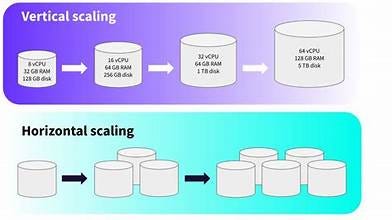In the dynamic world of system design, achieving scalability is paramount for ensuring a robust and responsive architecture. Two primary strategies, vertical scaling, and horizontal scaling, offer distinct approaches to handling increased demand and traffic. This article delves into these concepts, exploring their characteristics, advantages, drawbacks, and the critical decision-making process in choosing the right scaling option for your application.
Vertical Scaling:
Characteristics of Vertical Scaling:
Vertical scaling, also known as the 'scale-up' approach, involves enhancing the power of a single machine by upgrading its resources, such as processors and RAM. Key characteristics include:
- Easy Implementation: Vertical scaling is straightforward, requiring minimal effort to upgrade a single machine.
- Application Compatibility: It maintains compatibility with existing applications, making it suitable for small to mid-sized companies.
- Examples: MySQL and Amazon RDS exemplify successful implementations of vertical scaling.
Drawbacks of Vertical Scaling:
Despite its advantages, vertical scaling has limitations and drawbacks:
- Limited Upgradability: There's a finite scope for vertical scaling, constrained by the physical capabilities of the hardware.
- Single Point of Failure: A single server poses a higher risk of outages and hardware failures.
- Increased Costs: Upgrading hardware can be expensive, making it less cost-effective than horizontal scaling.
Advantages of Vertical Scaling:
Vertical scaling offers specific advantages, including:
- Increased Capacity: Upgrading a server's hardware boosts its performance and capacity to handle more requests.
- Easier Management: Managing a single node is less complex than handling multiple nodes in horizontal scaling.
Disadvantages of Vertical Scaling:
However, vertical scaling comes with limitations:
- Limited Scalability: The physical constraints of hardware limit the scalability potential.
- Increased Cost: Upgrading hardware can incur higher costs compared to horizontal scaling.
Horizontal Scaling:
Characteristics of Horizontal Scaling:
Horizontal scaling, or the 'scale-out' approach, involves enhancing performance by adding more machines to the network. Key characteristics include:
- Scalability with Distributed Systems: Achieved through distributed file systems, clustering, and load balancing.
- Effective Traffic Management: Traffic is distributed, ensuring efficient load balancing.
- Examples: Google (Gmail, YouTube), Yahoo, Facebook, and others effectively use horizontal scaling with Cassandra and MongoDB as notable examples.
Drawbacks of Horizontal Scaling:
Horizontal scaling comes with its own set of challenges:
- Complicated Architectural Design: Implementing and managing multiple nodes can be complex.
- Higher Costs: Adding more nodes increases system costs.
- Infrastructure Requirements: Extra networking equipment is necessary, including routers and switches.
Advantages of Horizontal Scaling:
Despite challenges, horizontal scaling offers compelling advantages:
- Increased Capacity: More nodes handle a larger number of incoming requests.
- Improved Performance: Load balancing across multiple nodes reduces the risk of server overload.
- Fault Tolerance: If one node fails, requests can be redirected, minimizing downtime.
Disadvantages of Horizontal Scaling:
However, managing multiple nodes introduces complexities:
- Increased Complexity: Handling multiple nodes can be more intricate than managing a single node.
- Increased Cost: Adding more nodes typically raises the overall system cost.
Differences Between Vertical and Horizontal Scaling:
- Load Balancing: Horizontal scaling requires load balancing, while vertical scaling does not.
- Resilience to System Failure: Horizontal scaling is more resilient, offering a distributed approach to handling failures.
- Machine Communication: Horizontal scaling relies on network communication, whereas vertical scaling uses inter-process communication.
- Data Consistency: Horizontal scaling may face data inconsistency, while vertical scaling maintains consistent data.
- Limitations: Vertical scaling has finite limits, while horizontal scaling allows limitless expansion.
Choosing the Right Scaling Option:
To make an informed decision, consider the following factors:
- Performance Requirements: Assess the performance characteristics and throughput of your application.
- System Availability: Determine the system's availability requirements and fault tolerance.
- Data Consistency: Address potential data consistency challenges.
- Scalability Goals: Define short-term and long-term scalability goals.
In many scenarios, organizations adopt a hybrid approach, combining elements of vertical and horizontal scaling to strike a balance between speed, consistency, resilience, and scalability.
Conclusion:
The journey to scalability is marked by nuanced decisions and careful consideration of business goals and system requirements. Whether opting for vertical or horizontal scaling, understanding the unique advantages and drawbacks of each approach is crucial. By aligning your choice with the specific needs of your application, you pave the way for a scalable, high-performance system that can adapt to evolving demands.
In conclusion, the choice between vertical and horizontal scaling is not one-size-fits-all. It requires a strategic approach, considering factors like budget, space, and long-term scalability goals. A well-informed decision ensures that your system remains responsive, resilient, and capable of meeting the challenges of the future.


